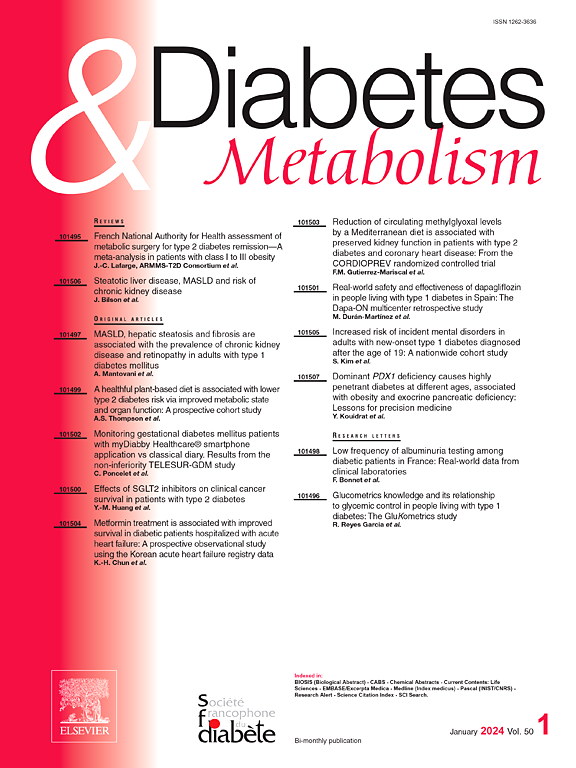在一组因新诊断或未控制的非自身免疫性糖尿病住院的成年患者中,计算机断层扫描检测胰腺病变的患病率和预测因素
IF 4.7
2区 医学
Q1 ENDOCRINOLOGY & METABOLISM
引用次数: 0
摘要
目的:。评估新诊断或未控制的糖尿病住院患者胰腺病变的患病率,并确定胰腺病理的潜在预测因素。方法:我们于2016年2月至2022年2月在布雷斯特大学医院进行了一项回顾性、单中心观察性研究。新诊断的糖尿病或未控制的糖尿病住院的成年患者在入院6个月内接受了计算机断层扫描(CT)扫描。排除1型糖尿病患者、既往胰腺切除术患者或已知胰腺腺癌病史患者。对临床、生物学和影像学资料进行分析。结果:412例患者中,53例(12.9%)出现胰腺异常(PA),其中胰腺恶性病变11例(2.7%)。PA的预测因素(P 2 (2.65 [1.1;4.98]);LDL/HDL比值≤3.0 (4.75 [2.03;11.10]);并且存在至少一种临床警告信号(饮酒、脂肪漏、腹痛)(2.29[1.21;4.33])。综合使用所有四个标准,412个CT扫描中有68个可以避免,没有遗漏病例。结论:在因糖尿病相关血糖失衡住院的患者中,胰腺病变的患病率显著,尽管恶性肿瘤仍然很低。年龄≥65岁、低体重指数和血脂改变可能有助于确定需要胰腺影像学检查的患者。未来的前瞻性研究应完善这些标准,以制定筛选出的高风险糖尿病人群早期胰腺癌检测的筛查策略。本文章由计算机程序翻译,如有差异,请以英文原文为准。
Prevalence and predictive factors of computed tomography-detected pancreatopathy in a cohort of adult patients hospitalized for newly diagnosed or uncontrolled non-auto-immune diabetes
Objective
To assess the prevalence of pancreatic lesions in patients hospitalized for newly diagnosed or uncontrolled diabetes mellitus and identify potential predictive factors for pancreatic pathology.
Methods
We conducted a retrospective, single-center observational study at Brest University Hospital between February 2016 and February 2022. Adult patients hospitalized for newly diagnosed diabetes or uncontrolled diabetes mellitus who underwent a computed tomography (CT) scan within six months of admission were included. Patients with type 1 diabetes, prior pancreatectomy, or a known history of pancreatic adenocarcinoma were excluded. Clinical, biological, and imaging data were analyzed.
Results
Among 412 patients analyzed, 53 (12.9 %) presented pancreatic abnormalities (PA), including 11 cases (2.7 %) of malignant pancreatic lesion. Predictive factors for PA (P < 0.05) included (odds ratio [95 % confidence interval]): age ≥ 65 years (2.00 [1.52;5.27]); body mass index ≤ 26.4 kg/m2 (2.65 [1.1;4.98]); LDL/HDL ratio ≤ 3.0 (4.75 [2.03;11.10]); and presence of at least one clinical warning sign (alcoholic use, steatorrhea, abdominal pain) (2.29 [1.21;4.33]). Using all four criteria together, 68 of 412 CT scans would have been avoided, with no missed cases.
Conclusions
The prevalence of pancreatic lesions in patients hospitalized for diabetes-related glycemic imbalance was significant although malignancy remained low. Age ≥ 65 years, low body mass index, and altered lipid profile may help identify patients requiring pancreatic imaging. Future prospective studies should refine these criteria to develop screening strategies for early pancreatic cancer detection in high-risk selected diabetic populations.
求助全文
通过发布文献求助,成功后即可免费获取论文全文。
去求助
来源期刊

Diabetes & metabolism
医学-内分泌学与代谢
CiteScore
12.00
自引率
4.20%
发文量
86
审稿时长
13 days
期刊介绍:
A high quality scientific journal with an international readership
Official publication of the SFD, Diabetes & Metabolism, publishes high-quality papers by leading teams, forming a close link between hospital and research units. Diabetes & Metabolism is published in English language and is indexed in all major databases with its impact factor constantly progressing.
Diabetes & Metabolism contains original articles, short reports and comprehensive reviews.
 求助内容:
求助内容: 应助结果提醒方式:
应助结果提醒方式:


